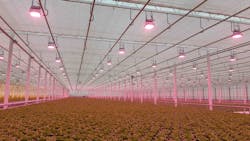Once again, a cold-climate horticultural farm has gone all LED in the greenhouse while taking extra measures to ensure that the winter climate remains warm enough in the absence of heat that in the past would have been buoyed by less efficient high-pressure sodium (HPS) lighting.
This time, lettuce grower Pawel Karpinski installed LED fixtures from Hyperion Grow Lights 3.75m (12.3 ft) above the hydroponically-grown crop at the latest extension to his lettuce greenhouse in Zuromin, Poland, which opened in September.
The new 6200m2 space (about 68,000 ft2) marked the second expansion of the lettuce facility since the first one opened in 2017 at the Karpinski-owned farm, called Gospodarstwo Ogrodnicze Karpińscy.
While each phase has accommodated 6200m2, the makeup of the light sources has changed each time. Phase one involved only HPS, phase 2 was a 50/50 mix of HPS and LED, and phase 3 was LED only.
In an interview on Hyperion’s website, Karpinski told Hyperion director Jonathan Barton that he first got interested in LEDs for the 2019 phase 2 expansion because their energy efficiency could help counter rising electricity costs, which was increasingly a concern with less efficient HPS.
But the same HPS inefficiency that drives up utility bills also helps provide helpful heat for winter growing. So partially out of concern for the indoor temperature, Karpinski committed only to a half LED arrangement, while also pumping in extra heat from a boiler.
Satisfied with the results, Karpinski went all LED in the latest 6200m2 extension, keeping the boilers going for heat.
Neither Karpinski nor Barton from London-based Hyperion revealed how much the farm paid for the lights, or how much the added heat detracts from the electricity-related savings.
But the big picture was one of financial savings.
“Plant growth is normal, but with high energy costs the payback is relatively quick,” Karpinski told Barton. “After a precise calculation of the investment costs of LED/HPS, taking into account the costs of replacing HPS bulbs, the return on investment in LED takes 3 years.” He also described the shelf life of the LED-grown lettuces as “much longer,” although he did not elaborate.
Karpinski installed 340 fixtures, enough LED lighting to deliver 100 μmol/s/m² of usable light energy to plants, Barton told LEDs Magazine.
It remains to be seen whether Karpinski might get interested in LEDs in his tomato greenhouses.
Hyperion is familiar with growers concerned about the lack of heat from energy-efficient LEDs. In 2019, Belgian farm Tomato Masters took heat precautions at a newly LED-lit facility, although it did not have to activate as many measures as it prepared.
The issue of heat management in LED and HPS tradeoffs is one of keen interest in the horticultural industry (see our list below). In some instances, such as at vertical farms with tightly stacked crops, HPS heat can be considered damaging.
Taking the heat
All LED, all the time, at Canadian vertical farm
Once again, LED moderates the greenhouse temperature
Less heat from LED grow lights? That’s good, say two tomato growers
It’s HPS for heat and LED for light at Dutch rose farm
Do LED grow lights provide enough heat in a greenhouse?
MARK HALPER is a contributing editor for LEDs Magazine, and an energy, technology, and business journalist ([email protected]m).
For up-to-the-minute LED and SSL updates, why not follow us on Twitter? You’ll find curated content and commentary, as well as information on industry events, webcasts, and surveys on our LinkedIn Company Page and our Facebook page.

Mark Halper | Contributing Editor, LEDs Magazine, and Business/Energy/Technology Journalist
Mark Halper is a freelance business, technology, and science journalist who covers everything from media moguls to subatomic particles. Halper has written from locations around the world for TIME Magazine, Fortune, Forbes, the New York Times, the Financial Times, the Guardian, CBS, Wired, and many others. A US citizen living in Britain, he cut his journalism teeth cutting and pasting copy for an English-language daily newspaper in Mexico City. Halper has a BA in history from Cornell University.





